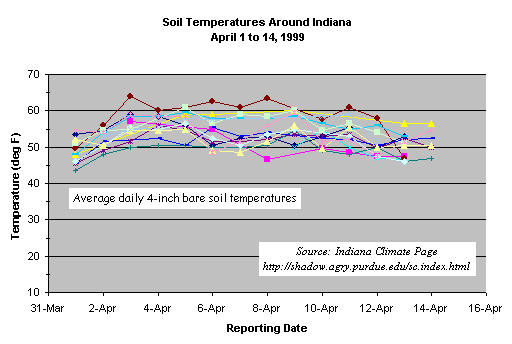
Fig. 1
The usual small percent of corn has already been planted throughout the state in recent weeks. Corn requires approximately 125 growing degree units (GDUs) from planting to emergence and should be calculated from soil temperatures, not air temperatures. Even though soil temperatures have been reasonably favorable for corn germination and emergence since April 1 (see Fig. 1), few, if any, areas of the state have yet accumulated enough GDUs since April 1 for corn to emerge (see Fig. 2) let alone since any more recent planting dates. Therein lies the risk associated with early planted corn in Indiana.

Obviously, delayed corn emergence increases the exposure of the seed and young seedlings to soil-borne insects and diseases plus surface crusting of the seedbed. It is not uncommon for early April-planted corn to take two to four weeks to emerge. Once emerged, another week or so passes before significant nodal root development occurs at the crown of the seedling. Until these roots develop, corn seedlings are extremely vulnerable to seed or mesocotyl damage from disease, wireworm, seedcorn maggot, and white grub. Additionally, slow germination and mesocotyl elongation increases the risk of underground leafing out due to soil crusting. The limited seed reserves of small sized seed (let's say 2000 seeds per lb or smaller) can also contribute to the susceptibility of early planted corn to these risks.
Bottom Line: It would be prudent to be walking early planted fields of corn and monitoring the progress of germination and emergence. Make sure your rotary hoe is readily accessible and in working order. Be prepared to replant if significant stand loss appears imminent.